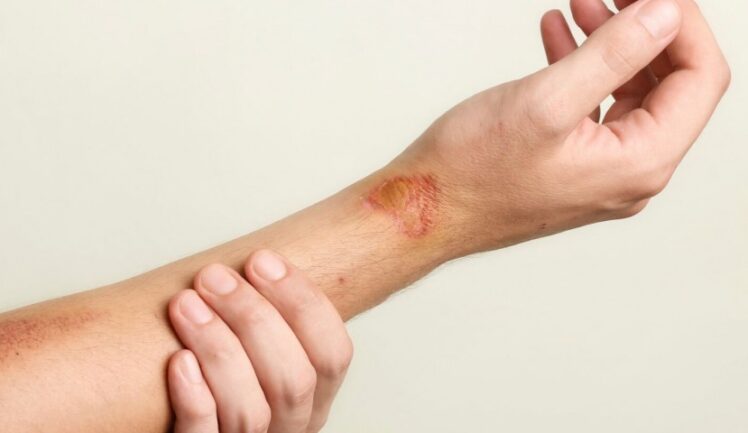Last updated: July 1, 2021
The Basics of Burn Care
Burns are common injuries caused by heat or chemicals. However, burns can differ significantly by their cause and seriousness. A minor burn heals quickly and without intervention, while a severe burn causes significant physical and psychological damage.
The American Burn Association states that approximately 486,000 patients receive medical treatments for burns each year. However, minor burns can be cared for at home. This article will cover the major types of burns, when to seek professional care, and the medical treatment for burns.
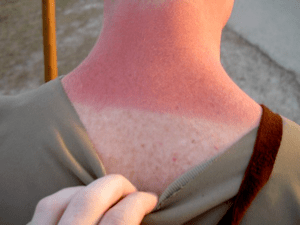
“Sunburn” by philkates is licensed under CC BY-SA 2.0
Types of Burns
Burns are labeled from first to the fourth degree, depending on severity. There are three layers of skin called the epidermis, dermis, and hypodermis. The epidermis is the first layer of skin, provides a barrier to infection, and regulates water loss. Next, the dermis is the next layer that primarily consists of connective tissues to protect the body from stress. Finally, the hypodermis, also known as the subcutaneous layer, is the border that connects the skin to the fibrous tissue of the bones and muscles.
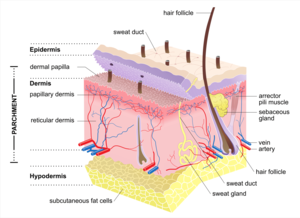
Structure of mammalian skin by Sean P Doherty is licensed under CC BY-SA 4.0
First Degree
A first-degree burn affects only the first layer of the skin called the epidermis. These burns are usually caused by:
- Sunburns: wear sunscreen with an SPF of 30.
- Scalds: Keep hot photos on the back burners with handles turned towards the back of the stovetop. Double-check your water heater temperature for baths and showers.
- Electrical sockets: Use child-proof covers and unplug appliances that aren’t used.
Healing can take anywhere from three days to three weeks. As your skin heals, it may peel. If your symptoms worsen or last longer than three weeks, consult a healthcare provider.
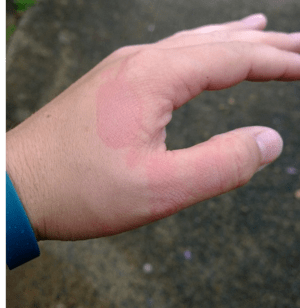
“First Degree” by Lachlan Hardy is licensed under CC BY 2.0
Second degree

“File: Second-degree burn after 2 days.JPG” by Themidget17 is licensed under CC BY-SA 4.0
The second-degree burn involves redness, severe pain, and blistering to the affected area. Second-degree burns benefit from being covered with sterile, non-stick gauze to protect the site and also may need antibiotic ointment.
Third-degree

“3rd degree burn with latex” by B L U S H is licensed under CC BY-ND 2.0
A third-degree burn penetrates the second layer of the skin called the dermis. You may need to wear tight clothing called compression garments to help skin heal. For third-degree burns, some patients need a skin graft of healthy skin to place over burned skin. A physical therapist may help to strengthen and stretch the affected areas.
Fourth degree
A fourth-degree burn is down to the muscle and the most severe. If you experience a fourth-degree burn, you should raise the injured body part above the heart. Chemical burns should be flushed. Do not apply ice, cream, or remove clothing that is stuck to the burn.
The professionals will clean the burn and remove dead tissue. You will get:
- Pain medication
- Apntpipbipoptic ointment
- Tetanus shot
- Intravenous fluids
Fourth-degree burns increase the risk of shock from the major inflammatory response. They are serious and affect more than the skin. However, the sooner that you seek treatment, the better. Some of the treatments are similar to a third-degree burn, such as skin grafts and physical therapy.
Complications
Burns that cover a large body area (more than 30%) cause cardiovascular, respiratory, metabolic, and immunological effects. To determine the burn percentage, health care professionals use the rule of nines that divides the entire body’s entire surface into 11 areas, each given a value of 9%. The additional 1% is credited to the groin. This differs in children because the rule of nines provides a child’s head with a more significant percentage of surface area on the body than adults.
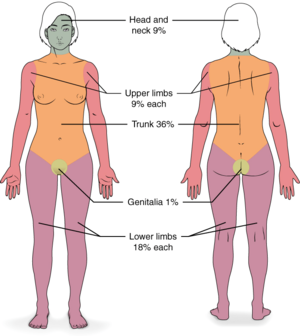
513 degree of burns by OpenStax College under license of CC by 3.0
The three zones of a burn are
- Coagulation: the point of maximum damage with irreversible tissue loss.
- Statis: this zone is potentially salvageable but has experienced decreased tissue perfusion, so reperfusion must occur.
- Hyperaemia: The tissue here will likely recover due to increased perfusion.
When to seek professional care
It is possible to manage minor burns without seeking emergency care. These involve:
- Blisters
- Pain
- Superficial redness like a sunburn
- Less than 3 inches in diameter You should seek the help of a professional if the burn is larger than three inches, deep, or appears infected. The most severe burns are not painful because they have destroyed the nerve endings that trigger a pain response.
Signs of infection include:
- Worsening pain
- Discharge from the wound
- A foul smell
- A fever
Treatment
You can treat most burns in the comfort of your home. There are some crucial steps to follow to treat your burns.
- Chill: Cool the burn with a wet compress or cool (not cold) running water.
- Remove: Remove any jewelry quickly and gently from the burned area before the area swells.
- Prevent: Don’t break blisters because they protect against infection. If one breaks, clean the area with water.
- Moisturize: Apply aloe vera or a moisturizing lotion.
- Protect: Bandage the burn with sterile gauze, but wrap it loosely.
- Relief: Take an over-the-counter pain medication like ibuprofen, naproxen sodium, or acetaminophen.
For major burns, call for emergency services immediately.
- Safety: The priority is ensuring the safety of the victim and yourself. For electrical burns, switch off the power before approaching.
- Breathing: If the burn victim is not breathing, begin rescue breathing.
- Protect: Cover the area of the burn with a cool, moist bandage or clean cloth.
- Prevent hypothermia: If the burn covers a large area, avoid submerging extensive burns in water to prevent hypothermia.
- Elevate: Raise the wound above heart level.
- Shock: Watch for signs of shock like shallow breathing, a sudden pale complexion, or fainting.
Severe burns require giving intravenous fluids, known as fluid resuscitation. This process will manage shock, intravascular volume depletion, and end-organ perfusion.
Be Prepared
While it’s a common household injury, prevention is the best initial step. Unfortunately, burns happen, despite our best intentions. The best way to prepare yourself to care for burns is to become first aid certified.
Source: https://pacificmedicalacls.com/basics-burn-care
